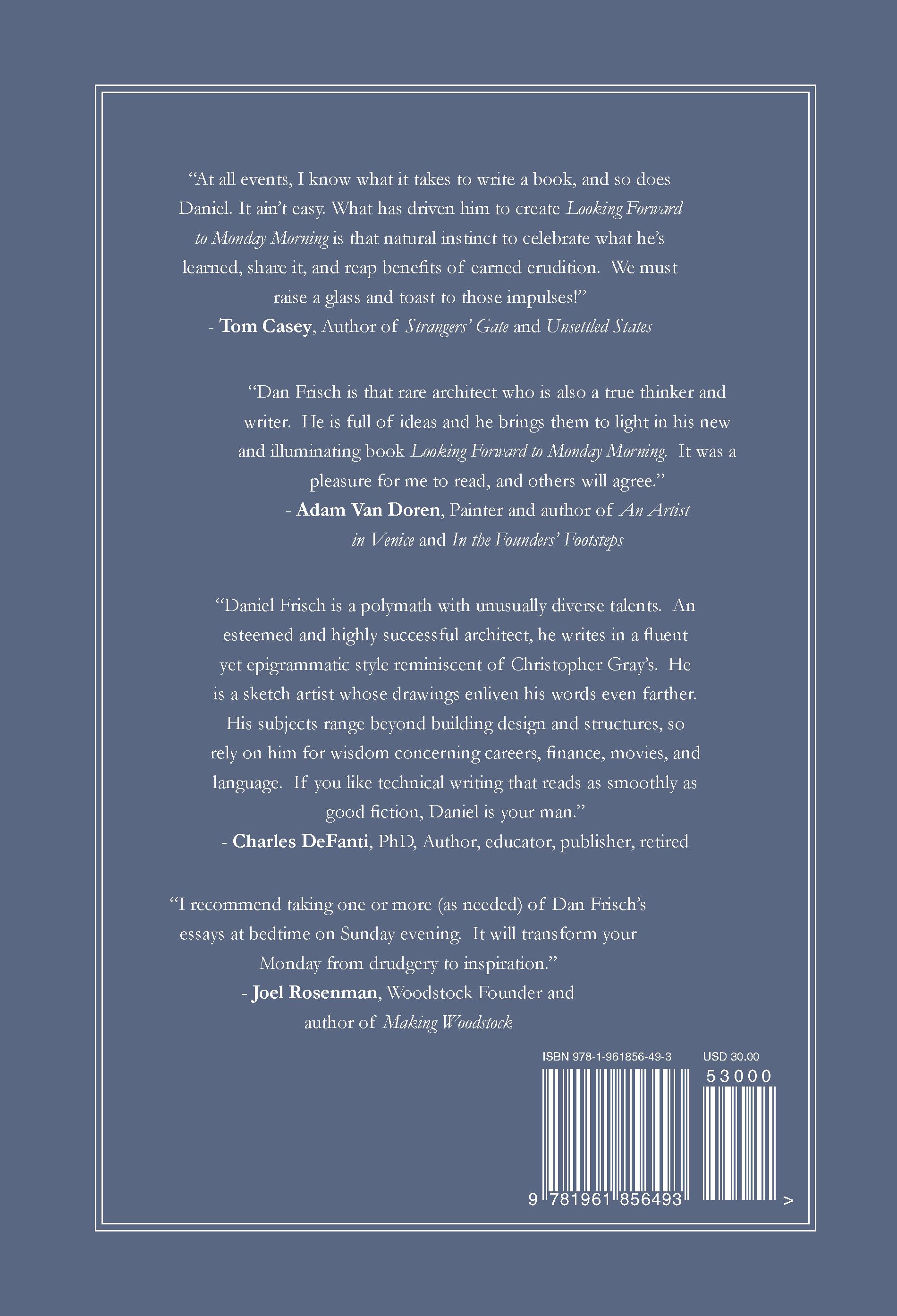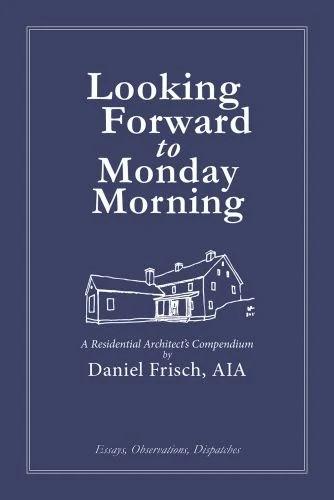

ORO
Looking Forward To Monday Morning
During the fall of 2016, I was strolling along one of Olmstead’s Central Park paths with a fellow dad from our kids’ school, and he said quite casually that I should write about my work. Although I had thought about it over the years, his remark gave me that little push to go out the next week and buy my first laptop. My initial efforts were introductory roadmaps for what I was going to write about and why. I was simply trying to explain and justify my project to myself, and looking back on the earliest pieces, it is very clear how much I didn’t know. I didn’t know how trying I would find writing to be or how proud I would feel when I finally came back to rewrite this “introduction.”
I was born a year after the baby boom in Manhattan, the second child of two natural science academics. At six months and with me just emerging from the NICU, my father accepted a teaching position at Northwestern, and we moved from New York to Chicago. Six years later, it was on to Grand Rapids, Michigan, for an exciting but short-lived teaching and research position, followed by an equally short-lived early retirement. After a few years of selling real estate, my parents opened an independent bookstore in Grand Rapids, and after that closed (a long family tradition of passionate but questionable entrepreneurship), they wrote and published a farmers’ market cookbook. I still reference the volume and occasionally search the internet for used copies in good condition. My parents have been gone for a while (father 1996, mother 2008), and while I miss them very much, I think they would have enjoyed watching me
ORO Editions
ORO

ORO
ORO
Little Ego : Big Ego
Stereotyping architects is easy. Beyond the superficial wire-rimmed glasses, black turtlenecks, and sport coats with elbow patches, architects are universally and fairly characterized as egotistical and arrogant. As a rule, we architects do little to discourage the stereotype. We dress the part, play along, and laugh at ourselves—all the while hanging on with pride as the imagery affords a certain distinction.
I suspect the apparent outsize ego of the architect is accurate, but also misunderstood. Fighting small battles, stubbornness, grandstanding, and winning arguments may all rather be signs of an undersized ego stemming from low self-esteem coupled with a fear of losing, or even worse, being wrong. Success in many disciplines derives from and fuels the ego, and in most disciplines, systems abound by which to measure success. Hollywood has the Academy Awards, and business has Forbes Magazine and its lists ranking the wealth of individuals and corporations. And sports, well, scorekeeping was invented to track and compare accomplishments.
Architecture and design, however, inhabit an alternative world of subjectivity, and especially so for residential practitioners. While Architectural Digest publishes and even ranks the most famous amongst us, most small firms toil anonymously, endeavoring to meet and exceed client expectations through quality design and competent project management. To succeed at this requires more than an average ego.
ORO Editions
succeed at satisfying today’s challenges through exuberant design, while simultaneously endeavoring to preserve our history and architectural heritage for future generations.
Note: Sadly, we lost Mario in 2010, and his family asked that I speak at his memorial service. I wrote my remarks the night before, and as short as they were, I barely made it through. A few months later, one of my friends shared that I am indeed a terrible public speaker. I only hope that my comments were better than my delivery, or my handwriting. If you can follow along, my remarks are copied here:

ORO Editions
Sketch by Mario di Valmarana
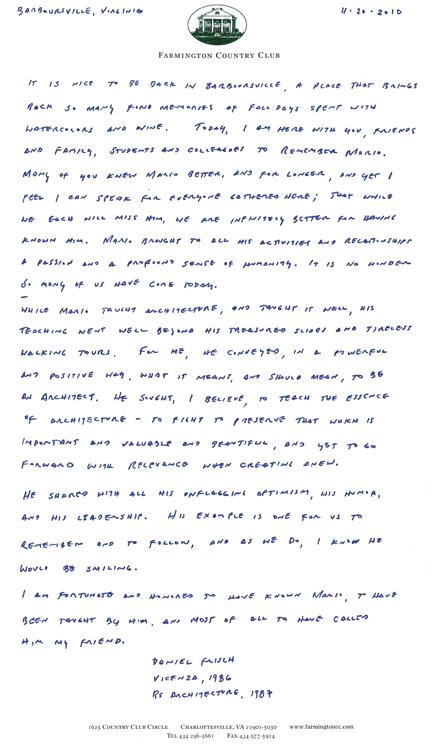
Note: During spring break of 2024, we returned to Lech and on a perfect March evening, I took a couple to visit Skyspace. I again was awed, as were they, and I am already looking forward to returning. In 2023, James Turrell installed a Skyspace on the roof of the Friends Seminary School in downtown Manhattan. No matter how tough the tickets are to come by, it is a much shorter commute than to Lech, and we will get there soon enough.

ORO Editions
James Turrell, Skyspace Lech, Oberlech, Austria
Photo: James H Schriebl
ORO
opted for a more cost-effective option: windows clad in aluminum or fabricated entirely out of composite materials. For die-hard preservation cases when budgets are expansive, we can still specify custom-fabricated, historically accurate windows, either weight and chain, or reproductions of pegged colonial era windows—both of which can last generations; but for the rest, we’ve moved on.
With both humility and wisdom, I realize my nostalgic bias for historic windows has been tempered by a life of continuing education.
ORO Editions
Brand Ambassadors
When I first started visiting jobs as a professional, I became fascinated with the similarities from project to project and contractor to contractor. Most notably, they all used the same power tools, not just the same manner of tools, but identical brands. It seemed every drill was made by Makita, as were reciprocating saws (“sawzalls”), unless they were by Milwaukee—which were also the two brands dominating the palm sander market. What wasn’t prevalent was a Makita or Milwaukee circular saw or jig saw—I am not sure I have ever seen one. On job sites, circular saws were by Porter Cable or DeWalt, and jigsaws were always Bosch—no others. The only decision the professional carpenter seemed to make was whether to use the Bosch D-handle version or the barrel-handle version. I observed that brands were so consistent that it was unimaginable for a company like Ryobi - which makes a great hand router—to break into one of the sub-markets for a specific tool. Does anyone other than Dremel even make a multitool? Apparently, the two great competitive equalizers of price and advertising have little impact when a professional is purchasing a tool. Even today, with Lowes and Home Depot and crowd-sourced reviews, a few specific brands dominate when we conduct our field inspections.
This observation about tools and brands has a perfect corollary in the world of appliances. Most major appliance manufacturers make appliances in every category, yet we rarely specify the same brand for more than a couple of appliances in a home. Wolf dominates ranges, and
ORO Editions
my portfolio, academic accomplishments, or career goals? Very often, the first response is to ask if the question could be repeated. Next comes the guessing game. The two most frequent guesses are that round covers can be rolled from place a to b, or that a round manhole cover would save material over a square. Both are true, but neither is the real reason. Only once in a great while can a candidate figure on the spot, even with prompting, that the reason is to save lives; round manhole covers cannot fall through the hole no matter which way they are oriented.
Provided the candidate has not read this essay or otherwise knows the answer, nor is one of the few who quickly stumbles upon the answer, our conversation becomes very informative. Going through the first couple of guesses goes quickly, and we can talk about how one solves a problem when the answer is “I don’t know.” Most candidates are very uncomfortable admitting a lack of knowledge, as I am certain I would be if the roles were reversed. What we like to see is a candidate who engages in a conversation filled with questions and follow-up questions. A robust back and forth is better than fielding ever further afield guesses or responding to an offer to Google it.
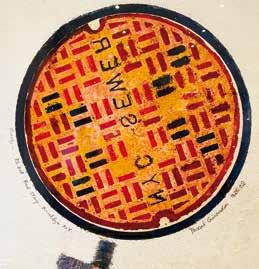
ORO Editions
Pascal Giraudon/Steven Lowy, Respect (Bedford- Stuyvesant, Brooklyn), 1992, Mixed media on paper.
Game Theory
I love playing games, which means what it should and is not simply a euphemism for being manipulative. I grew up playing board and card games, everything from checkers, chess, Mastermind, to gin, pinochle, and even the Japanese game of Go. By far, my favorite games were word games like Jotto, Boggle and Scrabble. When playing Jotto, a game in which opponents try to guess each other’s hidden words, I’d play without paper, mentally picturing the letter combinations and possibilities. For a number of years, I was the reigning family Boggle champion, which is frequently recounted at holiday get togethers. Today, both at home and office, we all play the daily New York Times “Spelling Bee,” a game whose goal is to make as many words as possible from a flower-looking diagram featuring six letters surrounding a central letter. Each of us tries to score enough points by finding words, especially the one or more pangrams which incorporate each of the seven letters, and to achieve “Genius” status. On not so rare occasions, working individually or together, we succeed at finding every possible word and a cute bee icon appears on our phone indicating that we are “Queen Bee” for a day. It is a fair observation that I gravitate to people who like to play games.
One of the many lucky breaks from childhood was having parents and a specific aunt who nurtured my game-playing passions. My scientist father and I usually battled over the chess or Go boards, both being strategy games where the of luck of the draw or a roll of the dice cannot influence an outcome. In theory and practice, the better more experienced and more focused player most always claims victory, and
ORO Editions
during construction that further the delta between budgeted and actual. Maintaining a positive attitude when project schedules and budgets slip can become extremely challenging, especially when a culture of blame erodes the collaborative spirit.
While the actual responsibility for maintaining schedule and budget lies with the general contractor, the architect directs the movie and manages the team. Along with designing, drawing plans, and preparing specifications, the architect’s job is to set the tone for a project. This cheerleading of sorts is most notably needed when additional work expense and schedule extensions threaten to infect a project that began as exciting and rewarding. Helping all parties maintain a high level of confidence in the team, the process, and the project outcome ensures that clients enjoy the process and make good decisions along the way.
There is a wonderful parable about the empty or full glass that goes something like this. Pessimists find a glass half-empty; optimists find a glass half-full; and the engineer finds the glass twice as large as it needs to be. I am happy to be an architect, not an engineer. Electing to measure the glass as half-full suits my vision, and I encourage others to join me in maintaining a positive attitude - no matter how tightly their jaws may be clenched.
ORO Editions
Curtain Emergencies
In the early 2000s, we collaborated on an apartment renovation project with a now-famous interior designer. Over the course of the project, the designer and I became friendly and when catching up by phone one Monday morning, I asked how his weekend had been. He told me with some noticeable glee that he had just fired a client. I asked him to elaborate, and he said he had received a call from his client over the weekend asking for an immediate callback—the subject matter being a “curtain emergency.” When he finally returned the call on Monday morning, he pushed back, stating that “unless said curtains were on (insert expletive) fire, there was nothing he could imagine that would qualify as a “curtain emergency.” After confirming that the client’s house had, indeed, not burned to the ground, he confessed that he’d chosen to become a decorator to celebrate the fun and style in life, and that the client might find someone better suited for her needs.
I recall exactly where I was when I had my own “curtain emergency.” I was standing on the first tee of a golf course in Hot Springs, Virginia, about to commence an afternoon round at an annual outing. My phone rang: the office was calling. Everyone at the office knew I was unreachable except in the case of an emergency, but should something truly important come up, to please call. We had just finished an apartment renovation on the Upper East Side and the interiors were being installed in my absence. The associate on the call was in a panic; there was blood on the very expensive just-delivered off-white Holly Hunt sofa. At first, I thought
ORO Editions
for being a “GC’s architect”—as are most by implication—and not an effective agent of the owner, which is supposed to be the architect’s primary role. Notwithstanding the inaccuracy of the agency premise, the widely held belief that architects sell out and are incented to assist general contractors in an effort to increase costs and inflate fees is absurd. No architect could operate an ongoing business within a community or ever have a repeat client if such an assignation were true.
Projects don’t always go perfectly. Architects can certainly contribute to delays through poor communication or design disagreements—and even through mistakes—but this venomous social media rebuke of our profession was particularly naked and slanderous. While I have no insight as to whether the project’s architect performed well or poorly, or if unusual circumstances contributed to delays, I find the broad character assassination of our shared profession truly sobering. My DFA family and many of my colleagues have spent a career confronting such sentiments through enlightened and fair professional practice, and our repeat clients and the friends we have made on all sides of the business tell us we have succeeded.
Yes Houston, we have a (public relations) problem, and it may be more endemic than I might ever have realized.
ORO Editions
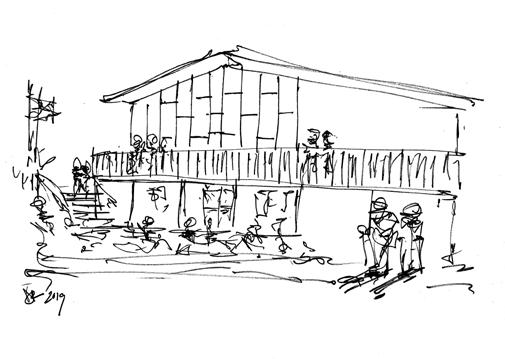
Since day one, our practice has been based on relationships, and I’ve found no better way of establishing new friendships than through sports. I moved to Manhattan directly after graduating from college, with few acquaintances and no disposable wealth. Given this lack of friends and funds, the prospect of enjoying a Hamptons summer share was remote. I did, however, have Central Park and a pair of soccer flats. That first summer, and then the next, I spent five or six hours each Saturday and Sunday playing pick-up soccer on the grassless Great Lawn with a ragtag group of Europeans, Latin Americans and Middle Easterners. Many days I was the only (North) American, learning to appreciate diversity and inclusion from the vantage point of a minority, and earning my way onto the pitch through quality touches and good humor. That my nickname was “Gringo” amuses me still. A few years later I picked up with an organized team sponsored by a small French restaurant. After each game we would decamp to Tout va Bien on the famed Restaurant Row for country pâté, sausages, and vin rouge. Our most talented player was a then recent transplant from Marseille who had played in the First Division and spoke barely a word of English, a perfect match to my lack of French. Yet, we got along famously on the field, and when he and
ORO Editions
Après Ski
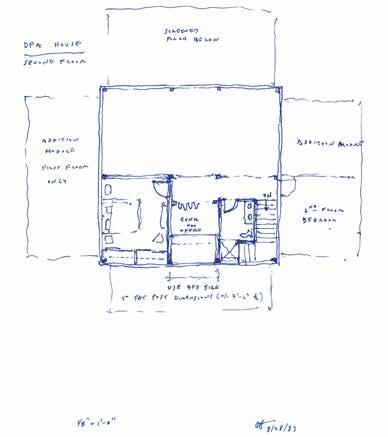

day trip the next time they were scheduled to visit. A few weeks later, we drove out to the lake and then met with the town building officials about the project. During the subsequent lunch, I recommended they abandon the shipping container concept and to let my team take a shot at designing a repeatable cottage for them. Just like any project, we started with programming and eventually fleshed out a concept that featured a simple salt-box volume with a timber frame great room and an efficient mechanical footprint. Unfortunately, the various contractors we asked to bid did not seem to agree that the homes could be built less expensively than our portfolio of custom homes. Either we had been zip-coded, we were not communicating well, or we hadn’t found the right answer. Without a contracting partner and not willing to start a pre-fab house company, the project was set aside.
We had spent several months designing an ideal cottage, and another several months trying to realize these early designs. Inertia set in, and then the COVID-19 pandemic hit and explorations ceased. When our team came back after the lockdowns and discussed our future goals, we decided to continue to explore. We renamed the project the DFA HOUSE and started over. New plans were drawn, the timber frame was simplified, and butter board models were built; just like any other project–-except we were now designing without a specific client in mind. We are now selling the vision to clients, really to anyone who thinks the efficiencies gained by a pre-designed structure might satisfy their needs. Four years after we started design work for a lake in New Jersey, we were sitting around the office looking at the model on the table and noticed, almost casually, that the DFA HOUSE footprint was still too large. We started over again.
As we go forward, we have many people watching closely. The current version of the DFA HOUSE is conceived as a Certified Passive House and will be an attainable house in that construction costs should be at least twenty-five percent lower than building custom from scratch. Construction timelines should be even more efficient. As we move from prototype to sales, we are considering starting a new company focused only on the development of this singular program, something I could never have envisioned when I first had lunch with my friend.
ORO Editions
League institution. And yet, as they are meant to be, commencement exercises marked another beginning along a many years journey. A great deal has happened since. I founded a firm, I started a family, and I’ve written this book of essays about it all.
I first put virtual pen to paper to write an introduction for an intended book in November of 2016; just over seven years ago. I had little more than a concept and a title, Looking Forward to Monday Morning, and a format, even though I felt I had at least a book’s worth of content rattling around in my brain. I believe I average an hour or so a day of writing (averaged, as I tend to write in bursts without discipline or a repetitive schedule). 365 days times seven years equals 2,555 hours, a little more than a year’s labor at an average fifty-hour a week job, but much less than Malcom Gladwell’s 10,000 hours of efficient practice needed to become an expert (Outliers, 2008). I am certain many more hours will be added to the total before I head out on a book tour or hear from students how much they enjoyed a particular essay.
Taken together, the essays in Looking Forward to Monday Morning tell the story of my thirty-plus years of practice; eight times more than the Gladwell minimum. Sending the manuscript(s) on to editors and publishers also offered me the chance to reflect on what to look forward to during the next thirty-three years. As I wrote in “Vocation : Aocation,” in the first chapter of this compendium, and I as have tried to affirm in each essay, I feel exceptionally fortunate—both looking back and looking forward—that my vocation and avocation are indeed one.

“SCHICK ELECTRIC RAZOR drawn by Daniel Frisch April 23,1982”
wall-mounted bookcases for our books, which have become the main decorative element. Books add color and warmth and activate an otherwise awkward and unremarkable space in our home. At DFA, we have a book called Living with Books (Alan Powers, 1999), a design book dedicated to rooms where books are the dominant theme. Whether people shelve their books by color, size, subject, or alphabetically, books highlight a homeowner’s’ personality. Some are messy, some are austere, some (like me) have OCD; whatever their quirks, readers make for good company.
If you are interested in the books that have contributed most to my thoughts and writings, please visit my bibliographic notes.
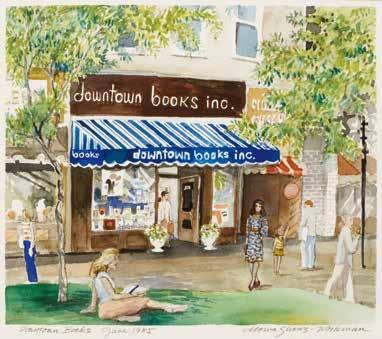
ORO Editions
Mona Shores-Workman, Downtown Books (Grand Rapids, MI), June 1985, watercolor on paper.
It’s a Wonderful Life
During our Monday morning meetings, I often use sports metaphors like “playing extra holes” to demonstrate a particular idea like scope creep. When explaining our STUDIO Program, DFA uses the terms “a la carte” and “prix fixe,” two clear descriptors lifted straight from restaurant menus. Most often, I use movies—favorite blockbusters, usually—when calling upon cultural references to illustrate a theme. Even though they are often lost on our younger team members, below are some of my most frequently quoted movies:
It’s a Wonderful Life (1946)
I hadn’t heard of the Frank Capra classic It’s a Wonderful Life until my first year at the University of Virginia. One of the student organizations sponsored showings before Christmas and it seemed as if the entire student population attended this annual rite. I joined the madding crowd, but with little expectation that the film would have a lifelong impact.
The film’s simple themes are as relevant today as when I first saw the movie, and as in 1946 when the film first aired.
• Slow and steady wins the race.
• We each affect the lives of many more people than we realize.
• Wealth should be measured not in dollars, but in the quality of friendships.
